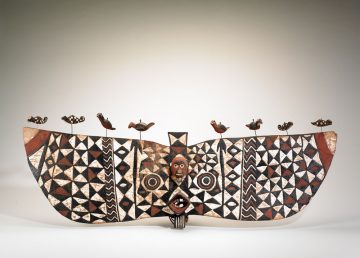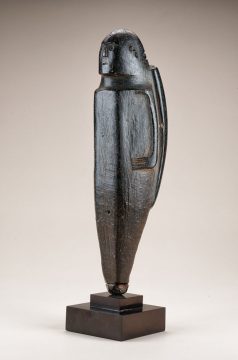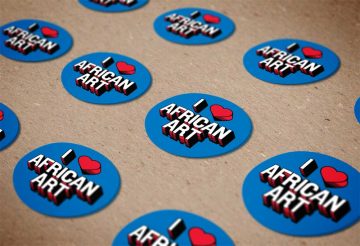How does one fall in love?
—Paul Tishman, 1981
What makes a collection great?
 Paul Tishman was often asked why he and his wife Ruth decided to collect African art. His simple reply below is a testimony to their lifelong love affair with the diverse arts of the African continent.
Paul Tishman was often asked why he and his wife Ruth decided to collect African art. His simple reply below is a testimony to their lifelong love affair with the diverse arts of the African continent.
In 1959 collectors Paul and Ruth Tishman bought their first two artworks, from the Benin kingdom of Nigeria, including an exquisite ivory female figure. Over the next 20 plus years they built one of the great private collections of African art. While unacquainted with Africa’s modern and contemporary works, the Tishmans nevertheless assembled a collection of classical African art unparalleled in its depth and breadth of materials, time periods, and geographic regions.
The Tishmans’ desire to share their African art with as many people as possible led to the sale of the collection to the Walt Disney Company in 1984. While the original plan of a permanent exhibition space at Epcot, a theme park at the Walt Disney World Resort in Florida, was never realized, the Walt Disney Company proved to be generous stewards, making the collection available for numerous exhibition loans and publications. In 2005, the Walt Disney World Co., a subsidiary of the Walt Disney Company, gave all 525 objects in the Walt Disney–Tishman African Art Collection to the National Museum of African Art.
Image caption: Collector Paul Tishman (left) and National Museum of African Art founding director Warren M. Robbins converse during the exhibition Sculpture of Black Africa, the Paul Tishman Collection at College of Fine Arts, University of Texas, Austin, 1971
Photographer unknown
Smithsonian Institution Archives, SIA2012-9616
Edo artist
Benin, Edo State, Nigeria
Female figure
Early 19th century
Ivory
37 x 9.4 x 10.3 cm (14 9/16 x 3 11/16 x 4 1/16 in.)
Gift of Walt Disney World Co., a subsidiary of The Walt Disney Company, 2005-6-3
Royal attendant. This ivory figure is one of the first two African artworks acquired by the Tishmans. A court artist carved this young woman with the distinctive coral bead jewelry and crest hairstyle of an attendant to the queen mother. A queen mother would have had her own palace with a separate court and attendants. Upon her death, the king would commission an altar in her memory. This figure was probably intended for such an altar.
Nuna artist
Boucle du Muhoun Region, Burkina Faso
Face mask
Mid-20th century
Wood, pigment, metal
60.5 x 173 x 17 cm (23 13/16 x 68 1/8 x 6 11/16 in.)
Gift of Walt Disney World Co., a subsidiary of The Walt Disney Company, 2005-6-47
Winged wonders. This mask is a vision of new beginnings. A master Nuna sculptor captured the patterned brilliance of the butterfly in the broad, richly decorated wings of this mask. The mask represents a nature spirit that combines human and animal forms, including birds and chameleons, to suggest knowledge and powers bridging earth and sky. Because butterflies signal the coming of rain in Nuna communities, they are connected with the start of the farming season.
Possibly Shona artist
Great Zimbabwe site (?), Masvingo Province, Zimbabwe
Male figure
Date unknown
Stone
33 x 9.5 x 9 cm (13 x 3 3/4 x 3 9/16 in.)
Gift of Walt Disney World Co., a subsidiary of The Walt Disney Company, 2005-6-119
Speculations in stone. Stone sculptures from different regions of Africa attest to the historic diversity of styles and artistic creativity across the continent. The origins and contexts of such figures, however, may be only partially understood today.
Despite a lack of archaeological data, the standing male figure and a related female figure in the British Museum have, since the 1950s, been linked to Great Zimbabwe, a 13th- to 15th-century religious center built by a powerful Shona kingdom. The use of stone and the suggestion of wings on this figure have led to unconvincing comparisons with the soapstone birds found at the site. Research to uncover the history of this intriguing sculpture is ongoing.
Yoruba artist
Plateau or Collines Department, Benin
Staff
Iron
Early to mid-20th century
123.2 x 11.4 x 15.9 cm (48 1/2 x 4 1/2 x 6 1/4 in.)
Gift of Walt Disney World Co., a subsidiary of The Walt Disney Company, 2005-6-264
Healing powers. A skilled Yoruba blacksmith crafted this iron staff, with its complex interplay of human and bird motifs, for a priest of the gods of healing, Ọ̀sanyìn and Erinle. In Yoruba culture, birds symbolize both ancestral mothers and the power of good to overcome evil.
The additional human imagery may refer to Ògún, the god of iron and the patron of anyone using metal tools or machinery. By providing iron blades to cut through the forest in the search for medicinal plants, Ògún facilitates the priest’s work.




